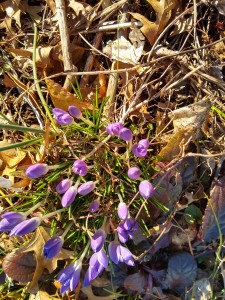 I am absolutely ridiculous about the first flowers of spring. I start checking the beds around New Year’s, hungry for even the smallest bit of color in my drab slice of suburbia. When I do spot something—crocus, snowdrop or winter flowering jasmine blossoms—I feel my spirits lift. It may be 25 degrees and sleeting, but those few flowers mean that spring is making itself known.
I am absolutely ridiculous about the first flowers of spring. I start checking the beds around New Year’s, hungry for even the smallest bit of color in my drab slice of suburbia. When I do spot something—crocus, snowdrop or winter flowering jasmine blossoms—I feel my spirits lift. It may be 25 degrees and sleeting, but those few flowers mean that spring is making itself known.
I feel a special affection for Crocus tommasinianus, the little early bloomers known to their admirers as “tommies”. They are not the bodacious Dutch giants that appear later, but small, slender, purple-pink specimens. Each one stands only a couple of inches high, but has a huge impact at this time of the year.
In my yard, the tommies are in the lower back garden, growing in a large clump. They have naturalized over time, which is typical of the species and part of their charm. Some vendors claim that tommies are immune to “squirrel landscaping”, which happens when squirrels dig up some of the bulbs and replant them in other places. All I know is that in my garden, a few tommies have migrated to other beds and are establishing floral beachheads in their new locations. Clearly the squirrels in my neighborhood don’t read the catalogs. However, the transplanted tommies look so lovely that I can almost forgive the squirrels for their indiscriminate digging.
You may have seen tommies and not known them. At the first sign of spring sun and warmth, the narrow petals open out to reveal the golden-orange anthers in the center of each flower. They have their season in the sun, with their grass-like foliage appearing after the flowers. Eventually all traces of the plants fade away, awaiting a return engagement the following spring.
Part of the large and diverse iris family, Crocus tommasinianus was first described back in 1847, and is native to European areas in the northern Balkans. Its winsome appearance and native toughness caught the attention of gardeners and its popularity spread. In fact, the species has gained such a following that I always wonder whether it has been depleted in its native range.
The squirrels may dig and replant tommies, but they don’t seem to eat them. Most horticultural sources label the bulbs and plants as resistant to deer and other garden varmints. This seems to be true in my garden, as the only damage ever done to tommies was inflicted by the less-than-dainty feet of Mr. Antlers and his crew. 
Plant Crocus tommasinianus in the fall and do so with a generous hand. They like sun, but since they bloom well before the deciduous trees leaf out, they are perfect for planting underneath those trees. They also like to be naturalized in grass. Whether you do the planting or the squirrels pitch in, just make sure that you don’t mow the area before the leaves have died back.
Breeders have not gone crazy with tommies, but a few varieties show up in commerce. If you are partial to pink, try ‘Roseus’, which dates to 1924. A mixture of ‘Roseus’ and species tommies makes a nice combination. ‘Barr’s Purple’ is a time-tested variety, with blooms that are a bit larger and darker than the species. ‘Lilac Beauty’ features flowers that are a softer, more blue-purple shade than ordinary tommies.
If you know someone with a clump of tommies, throw yourself on his or her mercy now and ask for a small division. It should grow bigger every year. Barring that, make a note for next fall and set aside a few dollars to buy some bulbs. They are relatively inexpensive, which is a good thing, because it takes about 100 of them to make a spring splash. Plant them three inches deep and don’t bother with individual bulb holes. Dig one large, shallow hole and position all your bulbs in it. Barring that, plant the tommies in clusters of three, five, seven or nine bulbs to give your spring array a natural look.
You can order tommies from Old House Gardens, 4175 Whitmore Lake Rd., Ann Arbor, MI 48105. (734) 995-1486, www.oldhousegardens.com (Catalog $2.00). They are also available from John Scheepers, 23 Tulip Drive, Bantam, CT 06750, (860) 567-0838, www.johnscheepers.com (Free Catalog)
